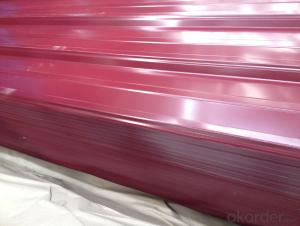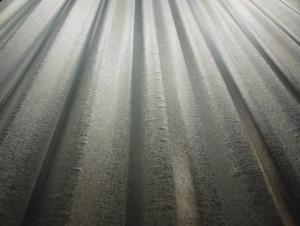HF PRE-PAINTED GALVANIZED STEEL SHEET
- Loading Port:
- Tianjin
- Payment Terms:
- TT OR LC
- Min Order Qty:
- -
- Supply Capability:
- 8000 m.t./month
OKorder Service Pledge
OKorder Financial Service
You Might Also Like
PRE-PAINTED GALVANIZED STEEL SHEET
THICKNESS:0.18mm-1.5mm
WIDTH:900mm-1250mm
COATING MASS:Z30-Z275
PAINT:PE、HP、HDP、PVDF、SMP、MATT、PVDF
COLOR:RAL Scale
COIL INNER DIAMETER:508mm/610mm
COIL WEIGHT:3mt-7mt
BASE MATERIAL:Hot-dip GALVANIZED Steel
Cold rolled plate of color coating steel plate
From the color plate cold rolling board production, has smooth and beautifulappearance, processing performance and has cold rolling board; but any tinyscratch the surface coating will put cold-rolled base plate is exposed in the air,so that the exposed iron quickly generated red rust. Therefore, this kind ofproduct can only be used for less demanding the temporary isolationmeasures and indoor materials.
Hot dip galvanized color coating steel plate
The organic paint coating on hot dip galvanized steel sheet on products for hotgalvanizing and coating plate. Hot dip galvanized Caitu besides the protective effect with zinc, organic coating on the surface also played isolation protection,prevent rust role, the service life is longer than the heat galvanized plate. The zinc content of hot dip galvanized substrate for general 180g/m2 (double),building external hot galvanized substrate galvanized weight up to 275g/m2.
Hot-dip zinc coated board
According to the requirement, also can use hot aluminium zinc plate as coating substrates (55%AI-Zn and 5%AI-Zn).
Electro galvanized and color coated sheet
Electricity galvanized plate as a substrate, coated with organic coating bakingincome products for electric galvanized Caitu, because the electric galvanized plate the zinc layer is thin, often containing zinc quantity is 20/20g/m2, theproduct is not suitable for production use in outdoor walls, roof. But because of its beautiful appearance and excellent processing performance, so it can be mainly used in household appliances, audio equipment, steel furniture, interior decoration, etc..
- Q: Are steel sheets suitable for automotive body panels?
- Indeed, automotive body panels can be effectively constructed using steel sheets. The automotive industry heavily relies on steel due to its exceptional strength and durability. Steel sheets possess the ability to endure the various pressures and strains encountered by body panels during vehicle operation, including impacts, vibrations, and adverse weather conditions. Moreover, steel can be effortlessly molded into intricate shapes, making it an optimal material for designing diverse body panel components. Furthermore, when adequately treated and coated, steel exhibits remarkable resistance against corrosion, guaranteeing the longevity and aesthetic appeal of the vehicle. In conclusion, steel sheets possess all the essential characteristics necessary for automotive body panels, rendering them a fitting choice for manufacturers.
- Q: How are steel sheets classified based on their surface finish?
- Steel sheets are classified based on their surface finish into different categories such as hot rolled, cold rolled, galvanized, and coated.
- Q: What is the difference between a smooth and diamond plate steel sheet?
- Smooth steel sheets are sheets of steel that have a flat, even surface, devoid of any raised patterns or textures. They are typically manufactured by rolling and smoothing the steel to achieve a uniform look. These sheets are commonly utilized in applications where a clean, polished appearance is desired, such as in architectural projects or for decorative purposes. On the contrary, diamond plate steel sheets, also known as tread plate or checker plate, possess a raised pattern of diamonds or lines embossed on their surface. This pattern not only adds visual appeal but also offers improved traction and grip, making it ideal for scenarios that necessitate slip resistance or protection against slipping hazards. Diamond plate steel sheets find frequent use in industrial settings, such as on ramps, stairs, or walkways, where increased safety and stability are required. In terms of functionality, the primary distinction between smooth and diamond plate steel sheets lies in their surface texture and the specific purposes they serve. While smooth steel sheets prioritize a sleek appearance, diamond plate steel sheets prioritize functionality and safety.
- Q: What are the insulation properties of steel sheets?
- Steel sheets have relatively poor insulation properties compared to other materials commonly used for insulation, such as fiberglass or foam. This is because steel is a good conductor of heat and electricity. It has high thermal conductivity, meaning that it can easily transfer heat from one side to the other. Therefore, steel sheets are not effective in preventing heat transfer and are not typically used as insulation materials on their own. However, steel sheets can still provide some insulation benefits when used in combination with other insulating materials. For instance, steel sheets can be used as a protective layer or cladding to enhance the durability and fire resistance of insulation systems. They can also be used as a radiant barrier, reflecting heat away from the building and reducing heat gain in warm climates. In summary, while steel sheets themselves do not have great insulation properties, they can play a role in enhancing the overall insulation performance when combined with other insulating materials or used in specific applications like radiant barriers.
- Q: What kind of steel plate is Q234?
- Q235 is divided into four quality grades. They are Q235A, Q235B, Q235C, Q235D. The elements of iron and phosphorus in the steel increased in turn.
- Q: Can steel sheets be used for food-grade applications?
- Steel sheets can be used for food-grade applications, but it is important to ensure that they meet certain criteria. Stainless steel sheets are commonly used in the food industry due to their corrosion resistance, durability, and ability to withstand high temperatures. They are also easy to clean and maintain, making them suitable for food processing, storage, and transportation. To be considered food-grade, steel sheets must have a high level of purity and be free from any contaminants that could potentially leach into the food. The steel should also be resistant to corrosion, as any rust or corrosion can contaminate the food and pose a health risk. In addition to the material composition, the surface finish of the steel sheets is also crucial for food-grade applications. Smooth, polished surfaces are preferred as they are easier to clean and prevent the accumulation of bacteria and other microorganisms. It is essential to choose steel sheets that comply with industry standards and regulations, such as those set by the Food and Drug Administration (FDA) in the United States or similar organizations in other countries. These standards ensure that the steel sheets meet the necessary requirements for food safety. Overall, steel sheets can be used for food-grade applications, but it is important to select the right type of stainless steel with the appropriate composition, surface finish, and compliance with relevant regulations to ensure the safety and quality of the food being processed or stored.
- Q: Can steel sheets be used in outdoor applications?
- Steel sheets are a great option for outdoor applications. They possess exceptional durability and strength, enabling them to withstand diverse weather conditions, thus rendering them suitable for outdoor use. The construction industry heavily relies on steel sheets for roofing, siding, and cladding purposes. Additionally, they are extensively utilized in outdoor storage sheds, fences, and gates. To enhance its corrosion resistance against moisture and environmental elements, steel sheets can be coated with galvanization or painting. Consequently, their ability to withstand exposure to such factors is greatly improved. All in all, steel sheets are an exceedingly dependable choice for outdoor applications, thanks to their strength, durability, and versatility.
- Q: What is the minimum order quantity for the steel sheets?
- The minimum order quantity for the steel sheets is 100 units.
- Q: Are the steel sheets resistant to chemicals?
- Steel sheets are typically able to withstand chemicals. Steel is renowned for its strength and durability, rendering it extremely resistant to corrosion caused by different chemicals. Nevertheless, the level of resistance may differ depending on the particular type and grade of steel employed, as well as the type and concentration of chemicals utilized. For instances involving highly corrosive substances like acids or alkalis, the implementation of supplementary protective measures such as coatings or surface treatments may be imperative to augment the chemical resistance of steel sheets.
- Q: What is the yield strength of steel sheets?
- The yield strength of steel sheets can vary depending on the specific grade and thickness, but typically ranges between 250 and 400 megapascals (MPa).
Send your message to us
HF PRE-PAINTED GALVANIZED STEEL SHEET
- Loading Port:
- Tianjin
- Payment Terms:
- TT OR LC
- Min Order Qty:
- -
- Supply Capability:
- 8000 m.t./month
OKorder Service Pledge
OKorder Financial Service
Similar products
Hot products
Hot Searches
Related keywords




























